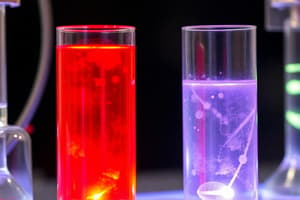Podcast
Questions and Answers
In redox reactions, which statement correctly describes the role of the oxidizing agent?
In redox reactions, which statement correctly describes the role of the oxidizing agent?
- It has a higher oxidation state than any other reactant
- It is always the product of the reaction
- It is the species that gains electrons (correct)
- It is the species that loses electrons
What is the primary function of the salt bridge in an electrochemical cell?
What is the primary function of the salt bridge in an electrochemical cell?
- To serve as the anode for oxidation
- To maintain electrical neutrality by allowing ion flow (correct)
- To provide a source of external voltage
- To enhance the oxidation reaction
Which process best describes electrolysis?
Which process best describes electrolysis?
- Using electrical energy to drive a non-spontaneous reaction (correct)
- Producing energy directly from a chemical fuel
- Generating electric current from spontaneous reactions
- Converting thermal energy into electrical energy
What is a characteristic of secondary batteries compared to primary batteries?
What is a characteristic of secondary batteries compared to primary batteries?
What is the purpose of the Nernst equation in electrochemistry?
What is the purpose of the Nernst equation in electrochemistry?
Flashcards are hidden until you start studying
Study Notes
Electrochemistry Study Notes
Electrochemical Cells
- Definition: Devices that convert chemical energy into electrical energy through redox reactions.
- Types:
- Galvanic Cells: Generate electrical energy from spontaneous chemical reactions.
- Electrolytic Cells: Require an external voltage to drive non-spontaneous reactions.
- Components:
- Anode: Electrode where oxidation occurs (loss of electrons).
- Cathode: Electrode where reduction occurs (gain of electrons).
- Salt Bridge: Maintains electrical neutrality by allowing ion flow between half-cells.
Oxidation-Reduction Reactions (Redox Reactions)
- Oxidation: Loss of electrons; increase in oxidation state.
- Reduction: Gain of electrons; decrease in oxidation state.
- Half-reactions: Represent oxidation and reduction separately.
- Oxidizing Agent: Substance that is reduced (gains electrons).
- Reducing Agent: Substance that is oxidized (loses electrons).
Electrolysis
- Definition: Process of using electrical energy to drive a non-spontaneous chemical reaction.
- Applications:
- Electroplating: Depositing a layer of metal onto a surface.
- Water Splitting: Producing hydrogen and oxygen from water.
- Process: Involves an external power source to push electrons, causing oxidation at the anode and reduction at the cathode.
Application In Batteries
- Primary Batteries: Disposable batteries that cannot be recharged (e.g., alkaline batteries).
- Secondary Batteries: Rechargeable batteries (e.g., lithium-ion, lead-acid).
- Key Concepts:
- Energy density: Amount of energy stored per unit mass or volume.
- Cycle life: Number of charge/discharge cycles a battery can undergo before losing capacity.
Nernst Equation
- Purpose: Relates the concentration of reactants and products to the electrode potential in electrochemical cells.
- Equation:
- E = E° - (RT/nF) ln(Q)
- E = cell potential under non-standard conditions
- E° = standard cell potential
- R = universal gas constant (8.314 J/(mol·K))
- T = temperature in Kelvin
- n = number of moles of electrons exchanged
- F = Faraday's constant (96485 C/mol)
- Q = reaction quotient (ratio of concentrations of products to reactants)
- E = E° - (RT/nF) ln(Q)
- Application: Used to calculate potential under varying concentrations and conditions.
Electrochemical Cells
- Devices that transform chemical energy into electrical energy through redox reactions.
- Galvanic Cells: Produce electrical energy from spontaneous chemical reactions.
- Electrolytic Cells: Utilize external voltage to induce non-spontaneous reactions.
- Anode: Site of oxidation, where electrons are lost.
- Cathode: Site of reduction, where electrons are gained.
- Salt Bridge: Allows ion flow between half-cells to maintain electrical neutrality.
Oxidation-Reduction Reactions (Redox Reactions)
- Oxidation: Defined by the loss of electrons and an increase in oxidation state.
- Reduction: Defined by the gain of electrons and a decrease in oxidation state.
- Half-reactions: Used to illustrate oxidation and reduction processes separately.
- Oxidizing Agent: The species that is reduced and accepts electrons.
- Reducing Agent: The species that is oxidized and donates electrons.
Electrolysis
- A process that employs electrical energy to drive non-spontaneous chemical reactions.
- Electroplating: Technique used to deposit a thin layer of metal onto a surface via electrolysis.
- Water Splitting: Method to generate hydrogen and oxygen from water.
- The process involves an external power source facilitating electron movement, leading to oxidation at the anode and reduction at the cathode.
Application In Batteries
- Primary Batteries: Designed for single use; cannot be recharged (e.g., alkaline batteries).
- Secondary Batteries: Rechargeable, allowing multiple use cycles (e.g., lithium-ion, lead-acid).
- Energy Density: Measured as the amount of energy stored per unit mass or volume.
- Cycle Life: Refers to the number of times a battery can be charged and discharged before performance declines.
Nernst Equation
- Provides a relationship between the concentration of reactants/products and the electrode potential in electrochemical cells.
- Equation Formula: E = E° - (RT/nF) ln(Q)
- E: Cell potential under non-standard conditions.
- E°: Standard cell potential.
- R: Universal gas constant (8.314 J/(mol·K)).
- T: Absolute temperature in Kelvin.
- n: Moles of electrons exchanged in the reaction.
- F: Faraday's constant (96485 C/mol).
- Q: Reaction quotient (ratio of product concentrations to reactant concentrations).
- Utilized to compute cell potential with varying concentrations and conditions.
Studying That Suits You
Use AI to generate personalized quizzes and flashcards to suit your learning preferences.




